A Joyful Celebration of Baseball – Hardball Times
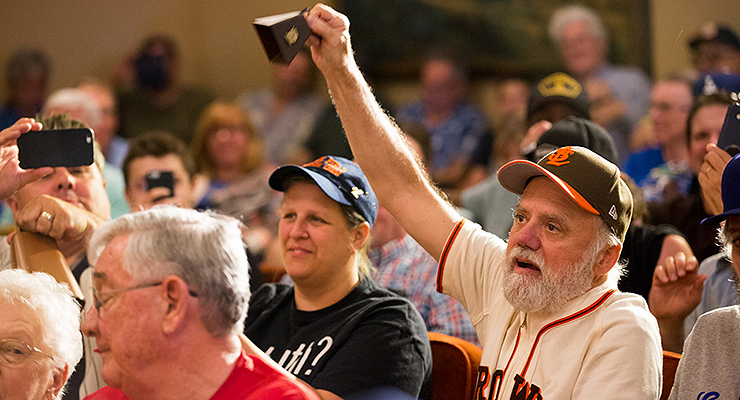
Head of the Eddie Geadel Society, Tom Keefe, had his cowbell at the ready. (via Jesse Saucedo)
Last Sunday, a standing-room-only crowd of over 200 gathered in the auditorium at the Pasadena Central Library. The occasion was the Baseball Reliquary’s 19th annual Shrine of the Eternals Induction Day. It’s an event that attracts all kinds of baseball fans, as well as “baseball royalty.” Audience members included Ty Cobb’s granddaughter, Cindy Cobb, and Adrienne Bratton, the daughter of Emmett Ashford (the first black umpire in the majors).
Many attendees were dressed in baseball caps and jerseys. There was more Dodger gear than anything else — this is Los Angeles, after all — but plenty of other teams were represented as well, including many which no longer exist, like the St. Louis Browns (Tom Keefe, head of the Eddie Gaedel Society, was decked out in a “⅛” jersey, naturally).
If you listened in on any random conversation, you’d hear baseball talk, sometimes contemporary in nature, sometimes historical, often both. While one group was discussing how Aaron Judge was re-elevating the Yankees’ status in New York, another was laughing at a story about Tommy Lasorda’s indignation over Sandy Koufax taking his roster spot.
“You see Justin Turner?” one attendee asks his companions. “If he keeps this up, he’ll be the Dodgers’ first batting champion since Tommy Davis.”
A man named Sam James, wearing a Detroit Tigers shirt, tells me he’s attended all 19 induction ceremonies, after spotting a newspaper ad for the first one in 1999. Now 68 years old, James has been a baseball fan since the 1950s, and fondly remembers the likes of Harmon Killebrew and Al Kaline. He considers himself more of a baseball history enthusiast and general baseball fan than a fan of any one team.
A love of the many fine points of baseball is what brought everyone to that room on that day, and it’s essentially the Baseball Reliquary’s foundational premise. Established in 1996, the Baseball Reliquary describes itself as a “nonprofit, educational organization dedicated to fostering an appreciation of American art and culture through the context of baseball history and to exploring the national pastime’s unparalleled creative possibilities.”
For two decades now, the Baseball Reliquary has amassed a collection of baseball artifacts. Certain pieces are sometimes selected for display in the Reliquary’s exhibitions, typically shown in local library branches (there’s several now available for viewing at the Pasadena Central Library). As of 2015, the Reliquary’s research collections are permanently housed at the Institute for Baseball Studies at Whittier College in Whittier, Calif. The Reliquary also puts on events, the crown jewel of which is the Shrine of the Eternals induction ceremony.
The Shrine of the Eternals stands apart from other projects that celebrate esteemed baseball figures in that its goal isn’t to merely honor those with the best numbers (although many Baseball Hall of Famers have also been inducted into the Shrine). Rather, the Shrine seeks to commemorate those whose impact on the game goes beyond the statistical. This includes trailblazers, like Glenn Burke, William “Dummy” Hoy, and Ila Borders; it includes oddballs, like Mark “The Bird” Fidrych and Bill “Spaceman” Lee; it includes fans, like legendary Brooklynite Hilda Chester; and now, it even includes fictional characters, with this year’s induction of Charlie Brown.
The induction ceremony featured speeches, award presentations and musical performances. Terry Cannon, the Reliquary’s executive director and that afternoon’s master of ceremonies, began the festivities just after 2 p.m.
The Introduction
Cannon opened by asking everyone who brought a cowbell to ring it. This was a tribute to Hilda Chester, a fixture of Ebbets Field who, in Cannon’s words, “sustained the Brooklyn Dodgers with her ever-clanging cowbells.” The joyful cacophony was just the first indication that Hilda’s spirit would be omnipresent.
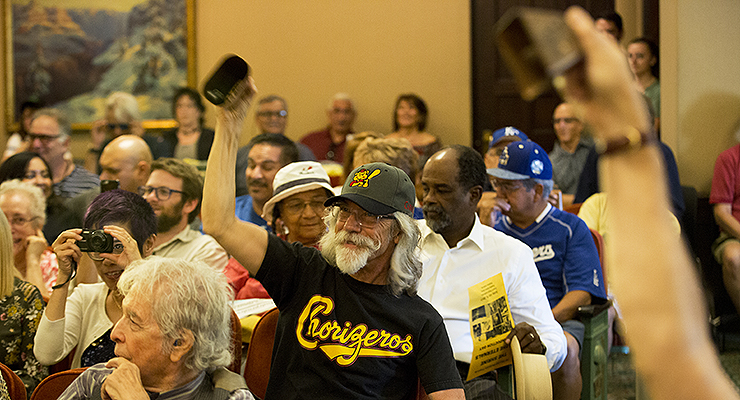
Attendees love to ring their cowbells in tribute to Hilda Chester. (via Jesse Saucedo)
Cannon continued with the annual tradition of sharing an anecdote about Hilda. This year, he chose a story that Vin Scully is fond of telling, which took place during a lightly attended afternoon game in Brooklyn. In Scully’s words:
All of a sudden, I heard this deep, almost basso profundo voice coming out of a woman, and she said: ‘Vin Scully, I love you.’ And the crowd roared, and I got red-faced and dropped my head.
“And when the crowd stopped, she said, ‘Look at me when I’m talking to you.’”
The National Anthem was performed by the San Fernando Valley’s own Symphomaniax, a four-piece string band featuring Ruth Bruegger on the violin, James Domine on the guitar, Glenn Grab on the cello, and Larry Muradian on the bass. They followed the anthem with a unique spin on “Take Me Out to the Ball Game,” which was interspersed with samplings of other songs, including the The Beatles’ “She Loves You,” Beethoven’s Symphony No. 5, and various TV themes.
The Awards
Following the Symphomaniax’s performance, the award presentation portion began. The first honor bestowed was the 2017 Hilda Award, named, of course, for Hilda Chester, and intended to especially honor noteworthy fans.
This year’s recipient was Cam Perron, a 22-year-old Tulane University business management graduate. Perron’s life’s passion is the preservation of Negro League history. At the age of 12, he began writing retired ballplayers for autographs, sending 20 to 40 letters a week to former major leaguers and former Negro leaguers. He found that the Negro league alumni tended to be quite enthusiastic in their responses, often sending replies that were two or three pages long. Perron started including his phone number in his letters, and often ended up having hours-long conversations with players.

Cam Perron was the recipient of the 2017 Hilda Award. (via Jesse Saucedo)
Once Perron had gotten in touch with every Negro leaguer whose address he could find, he began to ask his contacts if they could remember the names, ages and birthplaces of their teammates. He then used that information to track down a number of other former Negro leaguers who might have otherwise been lost to history.
Perron has since transformed his hobby into something remarkable. At the age of 13, he teamed up with Dr. Layton Revel, founder and executive director of the Center for Negro League Baseball Research in Carrollton, Texas, whom he describes as his “best friend.” The two have organized Negro Leagues reunions in Birmingham, Ala., for each of the past eight years.
Perron was also instrumental in getting MLB to launch a Negro League pension program, which provides anyone who can prove they played Negro League baseball for four or more years with a yearly $10,000 pension — a sum which, in Perron’s words, “really makes a difference” for a lot of guys. Perron has been featured twice on Real Sports with Bryant Gumbel, given a TED-Ed talk, and is currently in the process of working on a feature film based on his efforts.
Next was the presentation of the 2017 Tony Salin Memorial Award, named for a baseball historian, archivist and Reliquary member who passed away in 2001 at the age of 49. The purpose of the award is to honor those who have made significant strides in the quest of preserving baseball history.
This year’s recipient was Dr. Richard Santillan, a longtime professor of Chicano studies and founding member of the Latino Baseball History Project. Dr. Santillan is the lead author of the Mexican American baseball book series, which is set to release its 11th and 12th books this summer.
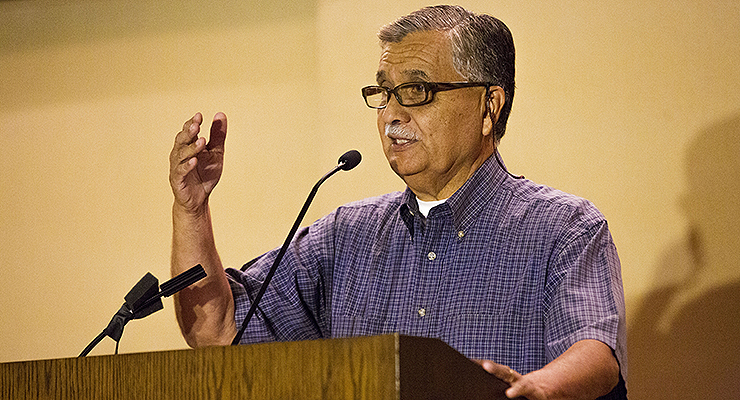
Dr. Richard Santillan was the recipient of the 2017 Tony Salin Memorial Award. (via Jesse Saucedo)
In his acceptance speech, Santillan reflected on the past recipients of the award, describing them as “courageous storytellers who have confronted, head-on, the one-sided story that passes, tragically, as baseball history — tinged, infected with racism, discrimination, and prejudice.”
Santillan spoke of his background as a sports fan and community organizer. To him, the Mexican American baseball book series is an endeavor “that has spiritually brought together every treasured aspect of my life: my love for baseball and sports, my love for Mexican-American history, my love for research, writing, and teaching, my love for politics, community self-determination, and social justice.”
A theme of the connections between baseball and social justice seemed to be developing. That continued with the keynote address.
The Keynote
The ceremony’s keynote was delivered by Dave Mesrey, a Detroit-based writer, historian and preservationist. In his speech, Mesrey explained baseball’s role in his formative years in Detroit, and how it has continued into adulthood. The son of Syrian immigrants, Mesrey oftentimes felt like an outcast, subjected to anti-Arab taunts by his schoolmates. In baseball, he found not just a form of escape, but a place where he could see stories like his own reflected.

Dave Mesrey was this year’s keynote speaker. (via Jesse Saucedo)
“The story of Tiger Stadium is really the story of Detroit,” Mesrey stated. “And it’s the story of America.
“It’s where immigrants from all over the world came to learn this quintessentially American game we all love so much. It’s where the Jews came to see Hank Greenberg, where Italians came to see Rocky Colavito, where Latinos came to see Ozzie Virgil. In the 1960s and ‘70s, when the Red Sox were in town, it’s where Arabs came to see Joe Lahoud. And after the Tigers signed Jake Wood, and Willie Horton,and Gates Brown, it’s a place where African Americans could finally come and see one of their own wearing the Old English ‘D.’”
As Mesrey noted, the Tigers are just one part of Detroit’s baseball history. The Detroit Stars were a Negro League team based in Hamtramck, technically its own town but with its limits surrounded by Detroit. When Hamtramck Stadium opened in 1930, none other than Ty Cobb threw out the inaugural ceremonial first pitch. The stadium is still standing, and remains in use to this day, in what’s become a predominantly Muslim community.
Mesrey expressed his appreciation for the Reliquary and its mission, and mused that many Detroit baseball legends would fit right in here, including his favorite, Mark Fidrych (a 2002 Shrine of the Eternals inductee). Mesrey, the founder of Bird Bash and a self-proclaimed “Birdhead,” had the opportunity to meet Fidrych at the last game ever played at Tiger Stadium.
Mesrey’s devotion to The Bird took him to Northborough, Mass., in 2009 to attend Fidrych’s funeral. There, Mesrey made the acquaintance of Stevie Graham, one of Fidrych’s childhood friends. Graham and Mesrey discussed Fidrych over coffee, before embarking on a driving tour of the town. It starts at Bird’s childhood home, then brings them to the farm where Fidrych spent his final days. The tour ends at the ballpark where Fidrych and Graham played ball while growing up.
The year after Fidrych’s passing, legendary Tigers broadcaster Ernie Harwell died. Mesrey’s instinct was to go to the site of the old Tiger Stadium, in a state of disrepair since its closing. He found several others there, playing catch and sharing remembrances of Ernie. Mesrey joined up with some of the people there to form the Navin Field Grounds Crew, who took it upon themselves to restore the field. Mesrey’s mission is now to focus on the upkeep of Hamtramck Stadium, which is one of just a handful of remaining Negro League stadiums.
The Inductions
Last week, here at THT, Don Malcolm, a longtime member of the Baseball Reliquary and the architect of the Big Bad Baseball Annual books, previewed this year’s Shrine inductees. Charlie Brown, Bob Uecker and Vin Scully were selected by voters from a ballot of 50 candidates. Scully made it in on his first ballot, and Uecker on his second; for the ever-resilient Charlie Brown it was his 10th time.
Charlie Brown was introduced by Craig Schulz, the youngest son of Charles M. Schulz. Between his work at Charles M. Schulz Creative Associates and his spot on the board of directors at the Charles M. Schulz Museum in Santa Rosa, Calif., Craig is dedicated to preserving his father’s legacy. In a Shrine induction first, Schulz flew himself to the ceremony in his own plane.
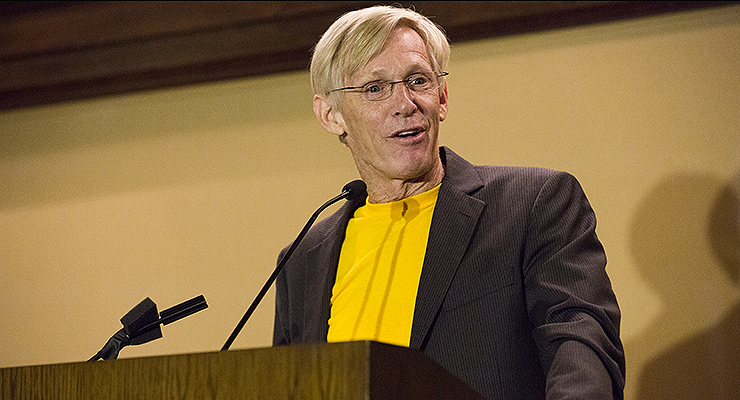
Craig Schulz accepted on behalf of that round-headed kid. (via Jesse Saucedo)
Schulz joked that Charlie Brown had asked him to accept the award on his behalf, as Brown thought it best to devote his time to making his hapless baseball team practice. Schulz spoke to the prevalence of baseball in the Peanuts comic strips: 1,195 of the nearly 18,000 strips drawn by his father (an avid baseball fan) centered on the sport.
Charlie Brown’s team had an estimated record of 2-930 across five decades. “Not even Bruce Bochy could make this team into winners,” Schulz said of the cast of characters that make up the Peanuts gang ballclub. But Charlie Brown should be seen as a source of inspiration. “He continues to play on when most would quit,” Schulz explained. “Why, you may ask? One word: hope.
“The hope that few of us will ever have. That someday will be his day. The day he pitches a no-hitter, or hits the winning run. The day he becomes the team’s hero.”
The second inductee was Uecker, longtime Milwaukee Brewers broadcaster. Uecker, who was working that day, could not attend, but he requested that former player Jay Johnstone accept on his behalf. Johnstone, remembered more as a legendary prankster than as a ballplayer, described Uecker as “one outstanding individual and a very, very funny man.”
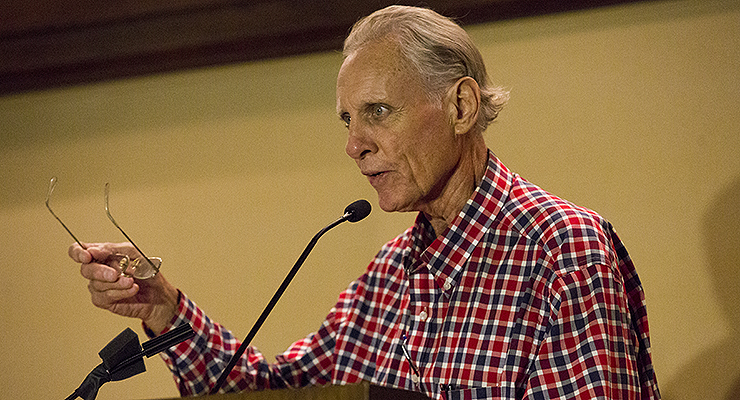
Jay Johnstone accepted on behalf of Bob Uecker. (via Jesse Saucedo)
Johnstone touched on Uecker’s playing career, the highlight of which, according to Bob, was when he walked in the winning run in an intrasquad spring training game. Johnstone also told a story of how proud Uecker was about once being intentionally walked by Sandy Koufax — until he discovered that the commissioner later threatened to fine Koufax if he ever did something like that again.
Following his retirement from baseball, Johnstone forayed into broadcasting, and sought Uecker’s mentorship. “As an announcer,” Johnstone said of Uecker, “you couldn’t find a better friend, a better helper if you’re an upcoming … announcer, and a better guy to be around in major league baseball.”
With the Baseball Reliquary being based in Southern California, it’s no surprise that the final inductee of the day, Vin Scully, holds a special place in the heart of event attendees. Prior to Scully’s induction, L.A.-based folk musician Ross Altman performed an original song he’d written for the occasion, entitled “Vin Scully From the Bleachers.” In it, he references some of Scully’s most iconic calls, and the colors most associated with him: “Red hair, golden voice, and Dodger blue.”
Scully’s award was accepted by Lisa Nehus Saxon, a L.A.-based sports reporter for more than two decades who now works as an educator. Saxon shared with the audience how she was first inspired to be a sportswriter by listening to Vin Scully call games on the radio. That’s hardly the only role that Scully played in her career, though.

Lisa Nehus Saxon accepted on behalf of Vin Scully. (via Jesse Saucedo)
Saxon, who was one of just three women covering baseball full-time in the mid-1980s, has experienced more than her fair share of sexism in her career. One particularly heinous incident occurred in Cincinnati while she was there covering the Dodgers. While attempting to conduct an interview, Saxon was physically picked up and removed from the Reds clubhouse for violating protocol — they didn’t allow women in there. Still feeling low about it the next day, Scully sat beside her on the team bus.
“Vin said that he had one two-part question for me,” Saxon recalled. “He wanted to know: if I could be anyone in the world, who would I want to be, and why?” Saxon responded with Gordie Verrell, a well-respected and well-liked sports reporter.
“Vin,” she continued, “the master of silence, remained silent for a few seconds before saying ‘Lisa, I’m so sorry to hear that.’ Vin went on to explain that, try as I might, that I would never be as good at being Gordie as Gordie is. He said that I owed it to myself to live my life in an authentic way. And he even posed a question: ‘What if you could be better than Gordie?’”
Scully told Saxon that was she was doing was “very important” and “remarkable.” His advice and encouragement gave Saxon the boost she needed to keep going, in spite of what had been an incredibly demeaning experience.
Saxon ended her induction speech with a callback to Cannon’s earlier anecdote, and had the crowd declare, in unison: “Vin Scully, I love you.”
There was Hilda’s spirit once again.
While Scully could not attend, he did email the Reliquary with the request that a note be passed along to the audience, which Cannon read aloud to bring the ceremony to a close:
It is heartwarming to know there are people who care about the game and spend their time keeping it alive and vibrant. I am humbled that they would include me in this year’s Shrine of the Eternals celebration, since I spoke of my love for the fans in the days leading up to my retirement. Even today, they are the wind beneath my wings.”
With that, the crowd dispersed. Some hung around to talk and enjoy light refreshments, which included boxes of Cracker Jacks. Some went to view the exhibitions, one dedicated to Babe Ruth and Emmett Ashford, another to photography of Tiger Stadium.
The audience that day was made up of people who deeply love baseball, who often — proudly — express their love in eccentric ways. It’s little wonder Hilda Chester has come to serve as the Baseball Reliquary’s emblem. To paraphrase Scully, she is the ultimate symbol of individuality in a large crowd, something that is often lost these days. It’s heartening that through the Baseball Reliquary — this community of individuals — there’s a place where her essence lives on.




